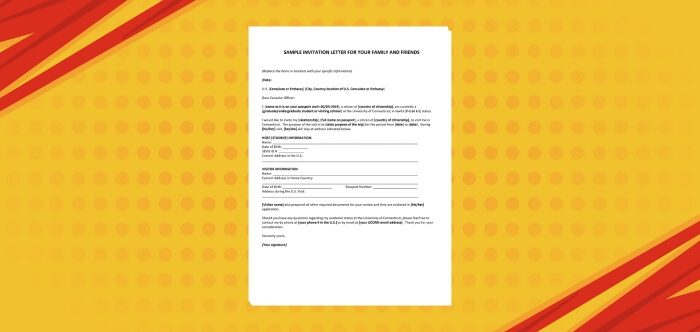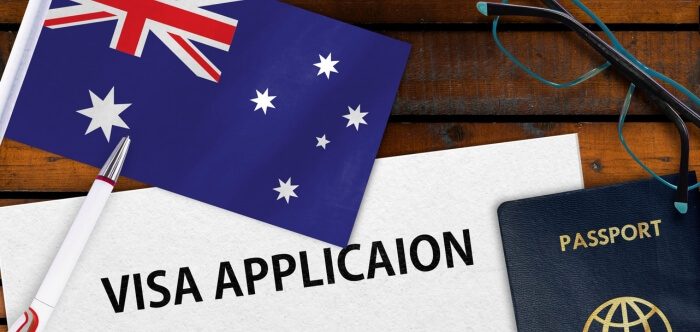When planning a trip to the USA, having a place to stay isn’t just about booking a hotel or finding a vacation rental. It can also be about getting an invitation from someone already living there. But the burning question is, who can invite you to USA? The answer may pleasantly surprise you.
A letter of invitation. This is a signed letter from a family member or friend based in the U.S. ensuring you have a place to reside during your stay. Ideally, your host would be a U.S. citizen or green card holder. Such invitations aren’t just a formality, but a genuine confirmation that someone in the States awaits your visit.
Interested to learn more? Dive deeper into our blog to uncover all the nuances and intricacies of this process, ensuring a smooth journey to the U.S. for you.
What is the Purpose of the Invitation Letter?
The invitation letter serves as a bridge between visitors and their hosts in the United States. By providing this document, hosts can assure authorities that the visitor has a legitimate reason to travel. It’s not just about extending hospitality; it’s a testament to genuine connections between individuals, families, or institutions.

Furthermore, the letter aids in streamlining the visa application process for many travelers. With an invitation in hand, potential visitors can offer proof of their intent and the nature of their stay. This concrete evidence often bolsters the applicant’s credibility, making the entire visa procedure more straightforward and less stressful.
The invitation letter also provides peace of mind to the inviting party. Knowing they have formally extended an invite and taken responsibility for the visitor ensures that both parties are clear about expectations. The clarity it brings to both the traveler and the host is invaluable, laying the foundation for a fruitful visit.
Types of Visa Applicants
Visa applicants come from diverse backgrounds and circumstances, each falling into specific categories based on their purpose for visiting a foreign country. Understanding these types is crucial for navigating the visa application process.
Tourist Visa (B-2)
Designed for leisurely visits, the B-2 visa allows travelers to explore U.S. attractions, visit family, or receive medical treatment. Most tourists lean on this visa for short stays. It doesn’t permit employment but offers a glimpse of American life.
Business Visa (B-1)
The B-1 visa suits professionals attending brief business-centric events in the U.S. It’s tailor-made for those participating in conferences from overseas, negotiations, or training sessions. While it allows business interactions, it strictly prohibits holding a job in the country.
Student Visa (F-1, M-1)
Aimed at academic aspirants, the F-1 visa is for those enrolled in colleges, universities, or language programs. The M-1 visa, on the other hand, serves vocational or non-academic students. Both visas mandate continuous study and have specific duration limits.
Work Visa (H-1B, L-1, O-1)
The U.S. offers multiple work visa categories. The H-1B is for roles requiring specialized knowledge, the L-1 caters to intra-company transfers, while the O-1 visa is for individuals excelling remarkably in arts, sciences, or business.
Exchange Visitor Visa (J-1)
This visa nurtures cultural and educational exchange. From university professors to summer work-travel participants, the J-1 visa embraces a diverse group. It offers a unique opportunity to immerse in U.S. culture while sharing one’s own.
Immigrant Visa (IV)
The IV is a pathway to permanent U.S. residency. Applicants often have family ties or employment offers in the country. Securing this visa is a significant stride towards a life in the United States.
With this comprehensive understanding, prospective visitors can make well-informed decisions. Choosing the appropriate visa is pivotal for a seamless U.S. experience.
Who Can Invite You to USA?
Journeying to the U.S. often involves having a trusted contact in the country. This raises a common question: “Who Can Invite You to USA?” Understanding the variety of eligible individuals or entities can simplify your travel plans.
Family Members
Immediate and extended family in the U.S. can extend an invitation. Whether it’s a parent, sibling, or distant cousin, family ties simplify the invitation process. Their residence and status in the U.S. can bolster your visa application.
Friends or Acquaintances
Personal connections play a vital role in travel. A close friend or even a casual acquaintance can provide a letter of invitation. Such gestures often enhance the credibility of your travel intentions.
Business Contacts
For professional journeys, U.S.-based companies or colleagues can invite you. Attending conferences, seminars, or business meetings becomes smoother with such invitations. These invitations indicate a clear professional purpose for the visit.
Academic Institutions
If you’re eyeing educational opportunities, U.S. schools or universities can be your inviter. Upon acceptance into a program, institutions often send formal invitation letters. These documents become crucial for securing student visas.
Event Organizers
Are you attending a significant event, organized by well-known organizer like Global Conference Alliance Inc., or function in the U.S.? Organizers of such events can send invitations. Whether it’s a seminar, workshop, cultural festival, or a major international conference like the aforementioned, an official invite aids your entry process.
Non-Profit Organizations
Various U.S.-based NGOs or charitable entities can also invite individuals. Especially if you’re collaborating or volunteering with them, their invitation holds weight. Such organizations often have experience navigating visa processes for international guests.
Recognizing the right entities or individuals to invite you is the first step toward a successful U.S. visit. A legitimate invitation often smoothens the visa acquisition process, paving the way for memorable experiences in the country.
The Invitation Process For Visiting The USA
Visiting the U.S. requires thorough planning, with invitations playing a critical role in many visa applications. The invitation process, while straightforward, has specific steps that need careful attention. Here’s a guide to help you navigate the invitation procedure for a U.S. visit.
Step-1. Determine the Appropriate Visa Type
Before initiating the invitation process, sponsors and applicants must identify the most suitable visa category for their purpose of travel. Common visa types include tourist visas, business visas, student visas, and family-sponsored visas.
Step-2. Sponsorship and Eligibility
For family-sponsored and employment-based visas, sponsors play a vital role. Sponsors must meet specific eligibility criteria, including U.S. citizenship or permanent residency, and must be able to demonstrate the ability to financially support the applicant during their stay.
Step-3. File Petitions and Applications
Sponsors typically need to file petitions or applications with U.S. government agencies, such as the U.S. Citizenship and Immigration Services (USCIS) or the Department of State. The exact forms and documentation required depend on the visa category.
Step-4. Pay Fees
Visa applicants are usually required to pay application fees. These fees cover the cost of processing the visa application and may vary depending on the visa type. It’s important to keep track of fee payments and receipts.
Step-5. Visa Interview and Documentation
After submitting the necessary forms and fees, applicants are often required to attend a visa interview at a U.S. embassy or consulate in their home country. During the interview, applicants must provide supporting documentation, such as a valid passport, visa application form, and proof of ties to their home country.
Step-6. Waiting Period and Processing Times
Visa processing times can vary widely depending on the type of visa and the volume of applications. It’s essential to plan well in advance to account for potential delays and ensure timely visa issuance.
Step-7. Visa Approval or Denial
After the interview and processing, applicants will receive a decision on their visa application. If approved, the visa will be stamped in their passport. If denied, applicants may receive a written explanation for the denial and, in some cases, the opportunity to appeal.
Step-8. Travel Preparation
Once a visa is approved, applicants should prepare for their trip to the United States. This includes booking flights, arranging accommodation, and ensuring they have all the necessary documents for entry.
To maximize the chances of a successful visa application, it is crucial to understand and follow each step of the invitation process. It’s advisable to seek legal counsel or guidance when navigating complex visa requirements to avoid potential pitfalls and complications.
Common Factors Affecting Visa Approval
The issue of visas is subject to a number of requirements that immigration officials carefully consider. Gaining an understanding of these elements can greatly increase the likelihood that an application will be accepted. Let’s examine some typical factors that affect visa decisions.
- Application Completeness: A fully completed visa application is paramount. Missing details can cause delays or denials. Always double-check every section before submission.
- Past Immigration History: Previous overstays or visa violations impact future applications. A clean immigration record aids approval prospects. Authorities examine past behaviors critically.
- Financial Stability: Applicants must demonstrate financial capability. Being able to support oneself is crucial during the stay. Adequate funds reduce potential dependency risks.
- Ties to Home Country: Strong ties like a job or family back home are influential. They indicate a higher likelihood of return post-visit. This factor alleviates potential overstay concerns.
- Purpose Clarity: A clearly defined visit purpose is essential. Ambiguity arouses suspicion. Always be forthright and specific about your intentions.
- Health Considerations: Certain health conditions can affect visa decisions. Comprehensive health insurance may be a favorable factor. Authorities assess health risks and associated costs.
- Criminal Record: A clean criminal background is beneficial. Crimes, especially serious ones, hinder visa chances. Disclosing any history is crucial, even for minor offenses.
- Invitation Authenticity: If invited, the invitation’s credibility is assessed. Genuine, verifiable invites boost approval odds. Any discrepancy can raise red flags.
- Consistency in Information: Inconsistent details across documents or interviews can be problematic. Accuracy ensures a smoother assessment process. Always maintain uniformity in the information provided.
- Country-Specific Policies: Each country might have specific visa considerations. Bilateral relations and current geopolitics can play roles. It’s vital to stay updated on any country-specific criteria.
Being aware of these factors provides visa applicants with a clearer roadmap. Tailoring applications while keeping these determinants in mind can pave the way for a successful visa outcome.
Conclusion
A trip to the United States can bring up a myriad of questions, one of the most common being: Who can invite you to USA? Well, the avenues are broader than one might think. From family members to friends, academic institutions, business associates, and even event organizers, there are multiple entities that can extend this valuable invitation.
An invitation letter isn’t just a mere formality. It acts as a beacon, signaling the traveler’s genuine purpose and intent. This key document, paired with the right visa type, can significantly bolster the credibility of a traveler’s application, making the journey to the U.S. more seamless and welcoming.
For anyone aspiring to visit the U.S., understanding these nuances is invaluable. It demystifies the visa process, transforming it from a daunting task into a manageable one. With the right knowledge and preparation, the dream of experiencing the United States becomes a tangible reality.







